Digital Poster
Imaging of Cerebrovascular Disorders & Treatment
Joint Annual Meeting ISMRM-ESMRMB & ISMRT 31st Annual Meeting • 07-12 May 2022 • London, UK

| Computer # | ||||
|---|---|---|---|---|
1121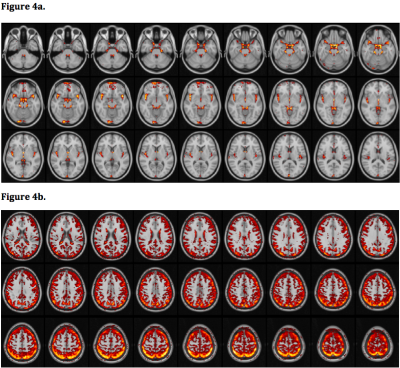 |
26 | Derivation of clinically significant low-frequency oscillations in resting-state BOLD fMRI data as a novel marker of endothelial dysfunction Video Permission Withheld
James Thomas1, Peter Jezzard1, and Alastair Webb1
1University of Oxford, Oxford, United Kingdom
We tested whether clinically-relevant, vascular-origin low frequency oscillations (LFOs) in 0.05–0.15 Hz could be derived on routinely-acquired resting-state BOLD-fMRI to determine their potential as a marker of vascular dysfunction in cerebral small vessel disease. Our case control study in 840 UK Biobank participants showed a statistically significant increase in LFOs in the arterial vessels of participants with high white matter hyperintensities, consistent with greater transmission of arterial blood pressure to the cerebral circulation in subjects with increased arterial stiffness. LFOs could provide a practical measure, applicable to large datasets and clinical practice, as an index of intracerebral vascular dysfunction.
|
||
1122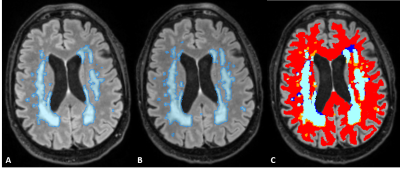 |
27 | White matter hyperintensities and their dynamic nature: diffusion MRI analysis of white matter hyperintensity regression
Angela CC Jochems1,2, Susana Muñoz Maniega1, Una Clancy1,2, Daniela Jaime Garcia1,2, Stewart Wiseman1,2, Gordon W Blair1, Rosalind Brown1,2, Ellen V Backhouse1,2, Carmen Arteaga1,2, Will Hewins1,2, Eleni Sakka1,2, Agniete Kampaite1,2, Michael S Stringer1,2, Michael J Thrippleton1,2, Mark E Bastin1, Maria Valdés Hernández1,2, Ian Marshall1, Fergus N Doubal1,2, and Joanna M Wardlaw1,2
1Centre for Clinical Brain Sciences, University of Edinburgh, Edinburgh, United Kingdom, 2UK Dementia Research Institute, University of Edinburgh, Edinburgh, United Kingdom White matter hyperintensities (WMH) have been shown to progress over time but they might regress too. Little is known about the regression of WMH as the main focus has been on progression. We investigate WMH regression and their dynamic properties using diffusion MRI. Areas of WMH change, both progression and regression, might have different tissue integrity properties than areas that are more stable, i.e. stable normal-appearing white matter (NAWM), become more hyperintense, or stable WMH. Mean diffusivity and peak width of skeletonized mean diffusivity (PSMD) might be most sensitive to subtle integrity changes before they become visible on structural MRI. |
||
1123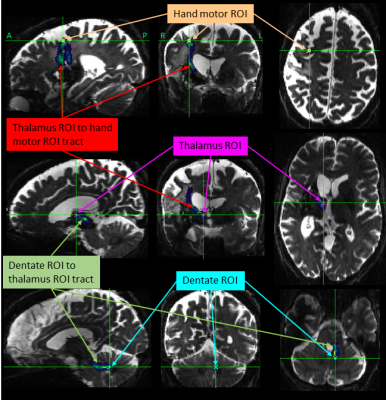 |
28 | DTI-defined structural integrity metrics of the functionally-defined dentatothalamocortical pathway are related to disability Video Permission Withheld
Jacqueline Chen1, Ajay Nemani1, Xuemei Huang1, Xin Li1, Kyle O'Laughlin1, Ela Plow1, Kenneth B Baker1, Mark J Lowe1, Stephen E Jones1, and Andre G Machado1
1Cleveland Clinic, Cleveland, OH, United States
Prior to the implantation of brain stimulating electrodes, it would be valuable to have an estimation of the severity of pre-existing injury to the pathways of interest. In chronic stroke patients, we used resting-state functional MRI and transcranial magnetic stimulation (TMS) to identify functionally connected regions of the dentatothalamocortical pathway. We found that diffusion tensor imaging metrics of the tract connecting thalamus to the hand-motor hotspot were significantly correlated with hand function. These results suggest that this non-invasive functional/structural MRI/TMS approach can provide pathway-specific injury metrics that may be useful as part of a pre-surgical evaluation.
|
||
1124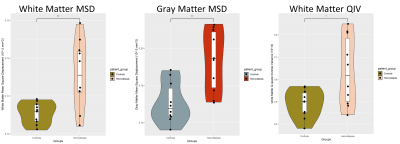 |
29 | Characterizing Brain Structural Differences in Hemodialysis Patients using MAP MRI
Wesley Thomas Richerson1, Brian Schmit1, and Dawn Wolfgram2
1Biomedical Engineering, Marquette Medical College of Wisconsin, Milwaukee, WI, United States, 2Department of Medicine, Medical College of Wisconsin, Wauwatosa, WI, United States
We collected brain MRI data using a custom, advanced diffusion sequence as well as typical T1 and T2 FLAIR anatomical images to characterize the differences between controls and Hemodialysis (HD) patients in a pilot study. We found decreased gray matter volume and thickness as well as increased white matter hyperintensity lesion volume in HD patients. Using the Mean Apparent Propagator technique, we found increased gray and white matter mean square displacement, white matter q space inverse variance and return to plane probability.
|
||
1125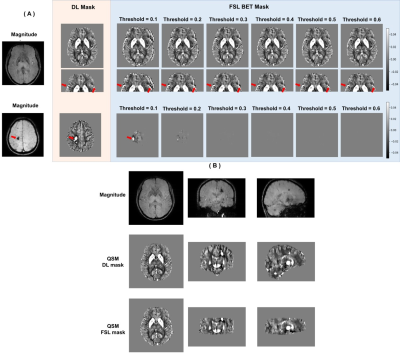 |
30 | Deep Learning Based Mask Generation Tools for QSM
Gawon Lee1, Ji Wan Son1, Ken SaKaie2, Woojin Jung3, and Se-hong Oh1,2
1Division of Biomedical engineering, Hankuk University of Foreign Studies, Yongin-si, Gyeonggi-do, Korea, Republic of, 2Imaging institute, Cleveland Clinic Foundation, Cleveland, OH, United States, 3AIRS Medical, Seoul, Korea, Republic of
Even subtle differences in masks can generate systematic but avoidable errors in QSM calculations. We believe these errors propagate through the calculation of the background phase. In this work, we assessed the effect of the mask on the QSM, selected optimal mask generation method and Deep Learning-based efficient mask generation method for in-vivo has been presented. This study represents the first step towards a fully-automated and optimal workflow for QSM calculation.
|
||
1126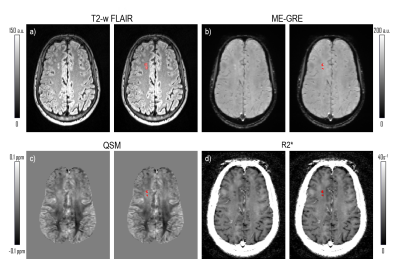 |
31 | Quantitative Susceptibility Mapping and R2* Mapping Suggest Demyelination in Silent Cerebral Infarcts in Sickle Cell Anaemia
Russell Murdoch1, Hanne Stotesbury2, Jamie Kawadler2, Dawn Saunders2, Fenella Kirkham2, and Karin Shmueli1
1Department of Medical Physics and Biomedical Engineering, University College London, London, United Kingdom, 2Imaging and Biophysics, Developmental Neurosciences, UCL Great Ormond Street Institute of Child Health, London, United Kingdom
To investigate the composition of silent cerebral infarcts (SCI) in sickle cell anaemia (SCA), we compared the magnetic susceptibility (χ) and transverse relaxation rates (R2*) of segmented SCI lesions to
|
||
1127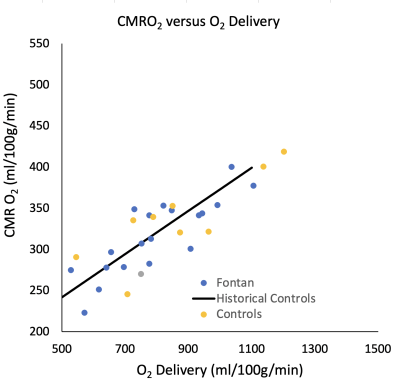 |
32 | Preservation of Brain Oxygen Metabolism in Emerging Young Adult Survivors of Fontan Palliation for Single Ventricle. Video Not Available
Jian Shen1, Silvie Suriany2, Clio Gonzalez-Zaccarias3, Botian Xu1, Ashok Panigraphy4, Jon Detterich2, and John C Wood5
1Bioengineering, University of Southern California, Los Angeles, CA, United States, 2Children's Hospital of Los Angeles-USC KSOM, Los Angeles, CA, United States, 3Neurosciences, University of Southern California, Los Angeles, CA, United States, 4Radiology, Children's Hospital Pittsburgh, Pittsburgh, PA, United States, 5Pediatrics, Children's Hospital of Los Angeles-USC KSOM, Los Angeles, CA, United States
Surgical palliation of single ventricular heart disease (Fontan procedure) leads to poor cardiac output, high central venous pressures, and long-term multiorgan morbidity. We report cerebral blood flow, brain oxygen delivery, and cerebral metabolic rate in 20 Fontan survivors and 9 control subjects. Fontan patients had lower cerebral blood flow and oxygen saturation but maintained cerebral oxygen delivery and cerebral metabolic rate of oxygen (CMRO2) because of polycythemia. Scattergram between CMRO2 and O2 delivery suggests similar oxygen extraction at the microvascular level in both groups. Taken together, these data suggest adequate cerebrovascular compensation to low cardiac output in Fontan patients.
|
||
1128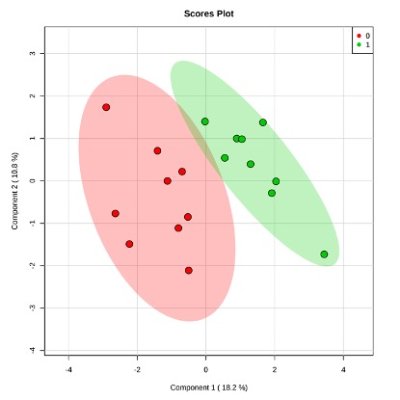 |
33 | Neurogenic metabolites after intravenous autologous stem cells infusion in Stroke: a high resolution NMR spectroscopic analysis of human sera
Ashu Bhasin1, Pawan Kumar2, S Senthil Kumaran2, Sujeet Mewar2, and MV Padma Srivastava1
1Department of Neurology, All India Institute of Medical Sciences, New Delhi, India, 2Department of NMR and MRI Facility, All India Institute of Medical Sciences, New Delhi, India
High resolution NMR spectroscopy to study the neural and cellular metabolites from serum samples of 14 chronic stroke patients after autologous bone marrow derived mononuclear stem cells and neurorehabilitation using 700 MHz NMR spectrometer. The data were processed using the Agilent software, Vnmrj2.3A. PLS-DA multivariate analysis was performed to explore biochemical shifts and upregulation between patients with stem cell infusion and controls. Using MetaboAnalyst (3.0) software, we observed elevated levels of myoinositol, choline, NAA, ML in one group 1 as compared to group 2 (groups undisclosed).
|
||
1129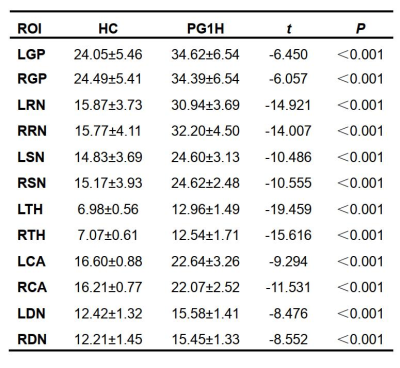 |
34 | Evaluating of Deep Brain Nuclei Iron Deposition in Primary Grade 1 Hypertension Patients by QSM: A Preliminary Study Video Not Available
Shiyun Zhang1, Kunhua Wu2, Guoli Bi2, Shaoyu Wang3, Yunzhu Wu3, Guoqing Xie4, and Qian Wang4
1Dali university, Dali, China, 2The First People's Hospital of Yunnan Province, Kunming, China, 3MR Scientific Marketing, Siemens Healthineers, Shanghai, China, 4Kunming University of Science and Technology, Kunming, China
Hypertension is becoming a common health problem all over the world. In this study, Quantitative Susceptibility Mapping (QSM) was used to compare the differences of iron deposition in deep brain nuclei between 28 primary grade 1 hypertension (PG1H) patients and 28 age-sex-matched healthy controls (HC). The results showed that the iron deposition in six deep brain nuclei ROIs were higher in PG1H than in HC. This study laid a foundation for exploring the relationship between the hypertension severity and iron deposition in deep brain nuclei. It was also of great significance for clinical exploration of the physiological and pathological mechanism of hypertension and the correct selection of the treatment scheme of hypertension.
|
||
The International Society for Magnetic Resonance in Medicine is accredited by the Accreditation Council for Continuing Medical Education to provide continuing medical education for physicians.